Find out What Type of Auto Fluid Leak is on the Ground.
Nobody likes walking out in the morning and right before you leave for work you find a large puddle under you car in the driveway or worse in the middle of your garage floor, what type of Auto Fluid Leak is it? Why did this happen to me? and so on…..
Not the best way to start your day, but …
No Worries my friend, after reading through this article you will have the confidence of being in the know. You now, will have the ability to identiy and know-how to treat the stain.
… lets get started.
Gas

Gas is probably the easiest liquid to identify because of its strong smell. If you have a large puddle under your car and it smells like gas, then you probably have a gas leak. Easy Right?! Fortunately, a gas leak doesn’t mean your vehicle is about to catch on fire. Even still, you should repair these leaks as soon as possible, especially given the price of gas these days. A leak at the rear of the vehicle indicates a hole in the tank while gas at the front usually means a break some where in the fuel line.
Antifreeze Fluid
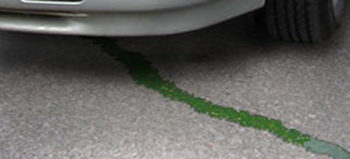
Antifreeze or coolant leaks are generally easy to spot because of their light green color. Coolant liquid will feel sticky to the touch and sometimes comes in pink or bright orange varieties. These leaks are very common and do not pose an immediate threat to the engine. They should, however, be fixed in a timely manner to avoid overheating, especially during hot months.
Transmission Fluid

Transmission fluid generally has a red or brown color and is usually thick and slick like oil. If you discover a red or brownish colored leak, your power steering or transmission system has a breach. You probably have a hole in a line or a transmission seal that needs to be repaired. A transmission leak typically occurs near the front of the car or in the engine bay.
Quick Tip on Colour…
Sometimes, the colour of the transmission fluid may vary slightly so we added this chart to help you identify the leak, if you are unsure if the fluid is in fact a transmission fluid leak, you can leave a piece of paper under the car to see what colour shows up…
Try this out…
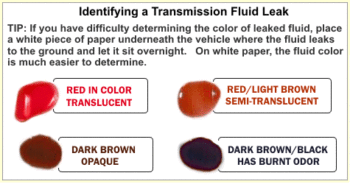
Brake Fluid
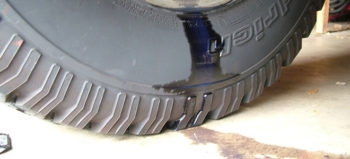
Brake fluid is usually dark yellow to brown in appearance and has an oily texture. If you suspect your car is leaking brake fluid, then you will need to get it towed immediately. Driving with leaky brake lines is a recipe for disaster and can lead to serious injury. Luckily, brake leaks are not that common and are usually located near the wheels or underneath the brake pedal.
Oil
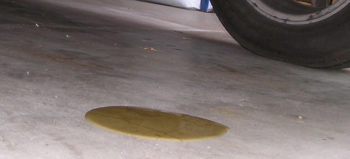
An oil leak is another popular fluid discharge found in vehicles. Oil leaks are very serious and should be fixed immediately to prevent engine problems. The color of the oil may vary depending on its age: newer oil appears yellow while older oil is dark brown or sometimes black. If you are unsure if its oil, check the smell. Oil should not give off an odor, while gear lubricants do smell bad.
Power Steering Fluid
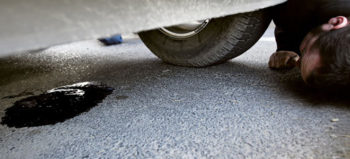
Power steering plays an important role in the handling of your vehicle. If you notice that turning has become more difficult, then you might have a power steering fluid leak. This fluid is usually a brownish-red, though it can appear darker when old. The key to identifying this leak is a change in the steering and location of the leak.
How to Clean all sorts of Stains from your Driveway
A Note on Changing Auto Fluids.
Be sure to keep up with regular mantainace, check all fluids often and don’t ignore any trouble lights in your vehicle’s dashboard. Have a look at this quick guide for reference.
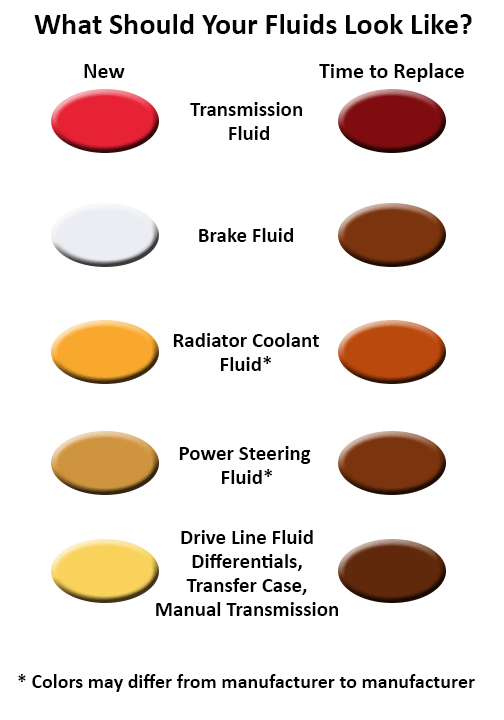
Fixing the Leak
The first step in fixing a leak is finding its origin. Start from the puddle and draw a straight line up to the nearest engine component. This should give you a general idea of where the leak is coming from. To find the exact location, wipe the area clean with a rag until it is completely dry. Then, spray a coat of foot powder on the area and wait for the fluid to start leaking. You may need to start your car for a short period to initiate the leak. Once you find the breach, replace the line or part and repeat the process until the leak goes away.
